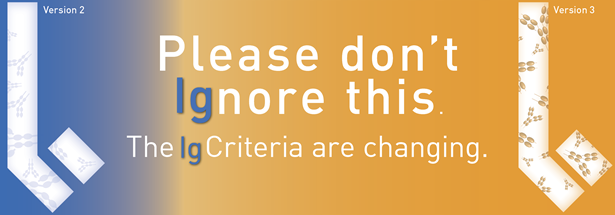
- Version 3 Criteria coming soon!
- Why is the Criteria Changing?
- How will the changes affect prescribers?
- How will the changes affect patients?
- Where can I find more information?
- Download
 PDF (257.71 KB) version of the newsletter
PDF (257.71 KB) version of the newsletter
Version 3 Criteria coming soon!
The Criteria for Immunoglobulin Use in Australia (the Criteria) is changing to Version 3. These changes will apply in BloodSTAR from 22 October 2018.
For more information please visit www.blood.gov.au/igcriteria-version3
Why is the Criteria Changing?
- To align with new evidence
- To ensure those whose health is most likely to be improved with Ig therapy can get it
- To manage the growth in demand for this precious, human-derived product.
Immunoglobulin (Ig) is a precious biological product derived from donated blood plasma, and as such, its use should be consistent with the evidence base and prescribed for the treatment of patients who are likely to benefit from immunoglobulin therapy, and for whom there are no safe and effective alternative treatments.
The continual significant annual growth in Ig use, the relatively high cost of Ig products and the potential for supply shortages mean that it is important to maintain a focus on ensuring that use remains consistent with an evidence-based approach and that Ig is able to be accessed under the National Blood Arrangements for those patients with the greatest clinical need.
The Criteria describes the conditions and indications for which the use of Ig is appropriate and government funded under the National Blood Agreement. Requests to access publicly funded immunoglobulin products in Australia must be authorised under the Criteria.
The changes to the Criteria will assist with meeting Standard 7 – Blood and Blood Products of the National Safety and Quality Service (NSQHS) Standards.
How will the changes affect prescribers?
Some current authorisations will move to the new Criteria automatically, while others may require prescribers to provide more information at the next patient review.
Indications will be more descriptive to help prescribers select the appropriate one for each patient.
The qualifying criteria will be more definitive in some conditions and additional evidence may be required.
In a small number of situations funding of Ig therapy has been withdrawn.
There will be better guidance for patient eligibility and requirements for patients to trial off Ig therapy.
A formal review of patient outcomes will need to be reported periodically in order to continue authorisation to receive funded Ig, for all ongoing conditions.
Reporting of review outcomes will be available for all conditions, not just those with an option to continue treatment.
Dosing controls have been reviewed and are more definitive where appropriate.
BloodSTAR will be easier to use.
Note: For NSW health providers –existing patient authorisations will be entered into BloodSTAR by a legacy process before the new version is released. Once this happens authorisations will move to the new Criteria as explained above.
How will the changes affect patients?
In some conditions patients may need to be diagnosed or reviewed by particular types of specialists, which may be different from current arrangements. Some patients may benefit from telehealth or remote reviews.
There are some changes to qualifying criteria for certain conditions. More clinical information may be needed to support initial or ongoing authorisation to receive funded Ig.
In a small number of cases patients may need to receive alternate therapies as funding of Ig may no longer be supported for some medical conditions.
Where can I find more information?
Detailed information for any changes to medical conditions covered by the Criteria will be coming before the new version is released. An additional email will be sent advising when this is available.
For more information and updates, visit www.blood.gov.au/igcriteria-version3
Contact Us
Telephone 13 000 BLOOD (13 000 25663)
Facsimile 02 6151 5300
Email iggovernance@blood.gov.au
Website www.blood.gov.au

